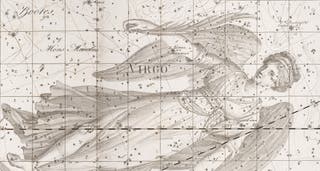Flamsteed, John. Atlas celeste. "Troisieme edition." Paris, 1795.
This "third edition" of Flamsteed's star atlas (actually the fifth overall, and the second French) was printed using the plates of the 1776 ed, but with a number of modifications. The 1776 edition had contained few nebulae (following the Flamsteed tradition), but now many of the Messier objects have been added. In addition, several new constellations were added. The period between 1776 and 1790 had seen the invention of 5 new constellations, several honoring political patrons, and two in honor of William Hershcel, the discoverer of Uranus, and this edition contains all of them. On the plate of Aquila (below), the “Royal Bull of Poniatowski” stands on the Milky Way.
If we compare the plate of the Orion/Taurus region with the corresponding plate in the 1776 atlas, we see that the "Harp of George" has been inserted beneath Taurus, and the "Telescope of Herschel" has been added between Orion's head and the horns of the Bull.

